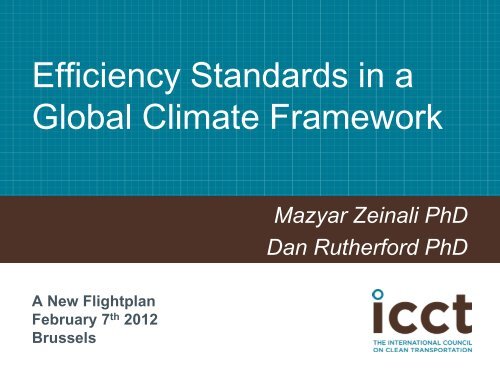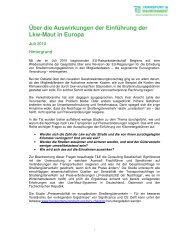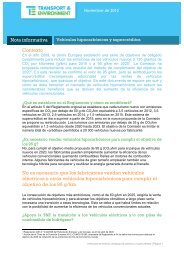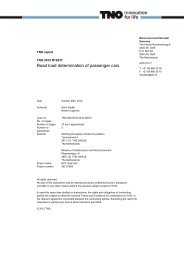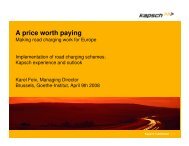Mazyar_Zeinali_presentation.pdfPDF, 992.9 KByte - Transport ...
Mazyar_Zeinali_presentation.pdfPDF, 992.9 KByte - Transport ...
Mazyar_Zeinali_presentation.pdfPDF, 992.9 KByte - Transport ...
Create successful ePaper yourself
Turn your PDF publications into a flip-book with our unique Google optimized e-Paper software.
Efficiency Standards in a<br />
Global Climate Framework<br />
A New Flightplan<br />
February 7 th 2012<br />
Brussels<br />
<strong>Mazyar</strong> <strong>Zeinali</strong> PhD<br />
Dan Rutherford PhD
Why Aviation Matters<br />
� 500% growth in<br />
emission since 1960<br />
� Expected growth in<br />
demand could more<br />
than triple aviation's<br />
share of<br />
anthropogenic CO 2<br />
� Does not include non-<br />
CO 2 impact which<br />
could significantly<br />
increase the climate<br />
impact of aviation
Historical Efficiency Trends - Aircraft<br />
� More steep gains<br />
from 1960 to 1990<br />
� Efficiency tailing off<br />
beyond 1990<br />
� SA – 1.6% reduction<br />
per annum from<br />
1960-1990; -0.6%<br />
per annum 2000-<br />
2009<br />
� TA – 1.0 %<br />
reduction per annum<br />
from 1967-1990;<br />
less than 0.2% per<br />
annum 2000-2009<br />
� Likely due to<br />
� Lack of new, more<br />
efficient designs<br />
� Technology being<br />
used to boost<br />
capability rather than<br />
to reduce fuel<br />
burn/emissions<br />
Efficiency for Newly Delivered Aircraft<br />
Twin Aisle<br />
Single Aisle
Efficiency Tradeoff – Capabilities v. Fuel<br />
Efficiency<br />
� Average range<br />
has increase by<br />
approximately<br />
25% since 1990<br />
� Upward trend for<br />
speed and<br />
payload<br />
� Technology gains<br />
used for<br />
increasing<br />
capabilities with<br />
tradeoff of<br />
efficiency<br />
Twin Aisle
Improve Efficiency Through a Basket of<br />
Measures Impacting Supply Side AND<br />
Demand Side
Supply Side Impact – Efficiency Standard and<br />
Capabilities<br />
787-8 Dreamliner from JFK<br />
BTS 2009 B777<br />
Range from 14200 km to 15200 km Majority of flights fall Below Max Capabilities<br />
ICAO Report of the Independent Experts (Doc 9963) –<br />
“…it has been found that quite modest changes in design Mach number,<br />
design range, and wing span can lead to additional savings….” comparable<br />
to changes resulting from moderate regulatory pressure
Supply Side Impact – New Aircraft Efficiency Can Be<br />
Improved Significantly Mid-term<br />
� Technology Improvements<br />
� -10% engine SFC<br />
� - 8% aero drag<br />
� +15% structural eff.<br />
� Tighter Optimization to<br />
Mission<br />
� 30% reduction in max. range<br />
� 30% reduction in cargo capacity<br />
� Small reduction in Mach number<br />
� Results:<br />
� 23% reduction in airframe<br />
weight<br />
� 11,000 km range (SFO-HKG)<br />
� 28% reduction in seat-km<br />
emissions (777-200ER basis)
Supply Side Impact – Efficiency Standard<br />
and Technology<br />
� ICAO global CO 2<br />
standard would<br />
provide supply side<br />
improvements<br />
� ICAO has<br />
concluded that<br />
moderate<br />
regulatory pressure<br />
may almost double<br />
efficiency trend<br />
beyond BAU<br />
� Beyond technology<br />
impact – new<br />
designs,<br />
capabilities (e.g.<br />
range, speed), and<br />
one size fits all?<br />
CAEP Technology<br />
Scenario Boundary
Demand Side - Efficiency for 2010 Top Half of<br />
Aircraft Fuel Flown by US Airlines<br />
� Top Half - 7 aircraft<br />
account for over<br />
50% of all reported<br />
Aircraft Fuel in<br />
2010<br />
� Aircraft with 1982<br />
entry-into-service<br />
best performer<br />
� Worst performer<br />
25% more<br />
emissions than<br />
Best Performer<br />
� Choice of and how<br />
airlines use aircraft<br />
matter<br />
2000 km<br />
100% PLF
Demand Side Efficiency Example<br />
� Best Performer<br />
� B757-200 – 737 g CO 2/TK<br />
� Worst Performer<br />
� MD-82 – 951 g CO 2/TK<br />
� Worst from ATL to IAH<br />
Approx. 29% less efficient<br />
than best on CO 2 basis<br />
� Improve Demand side<br />
efficiency – MBM’s<br />
Image source: gcmap.com
Summary<br />
� Both Supply and Demand Side Impacts on<br />
Efficiency<br />
� An efficiency regulatory standard influence<br />
will be reflected in supply side technology<br />
and design<br />
� MBM’s influence on demand side efficiency<br />
includes gains in fleet and operations,<br />
among others.
Thank You<br />
<strong>Mazyar</strong> <strong>Zeinali</strong><br />
mazyar@theicct.org<br />
415 202 5747
• ICAO Report – Policy<br />
pressure can reduce<br />
emission significantly<br />
beyond BAU<br />
• Significant<br />
Opportunities for<br />
Improvement<br />
“The [independent experts] have come to realise that a considerable part of the<br />
benefit of improved technology introduced in the past has been used to improve<br />
the performance of the new aircraft, mainly range, rather than to reduce fuel burn<br />
per ATK.”<br />
“Report of the Independent Experts on the Medium and Long Term<br />
Goals for Aviation Fuel Burn Reduction from Technology.” 2010. ICAO Doc 9963.<br />
Slide 13
Demand Side - Aircraft Fuel (US)<br />
� 4 aircraft with<br />
entry-into-service<br />
(EIS) in 1980s<br />
� Only 1 with EIS<br />
post 2000 (2001)<br />
� What Does this<br />
mean for<br />
Emissions?


